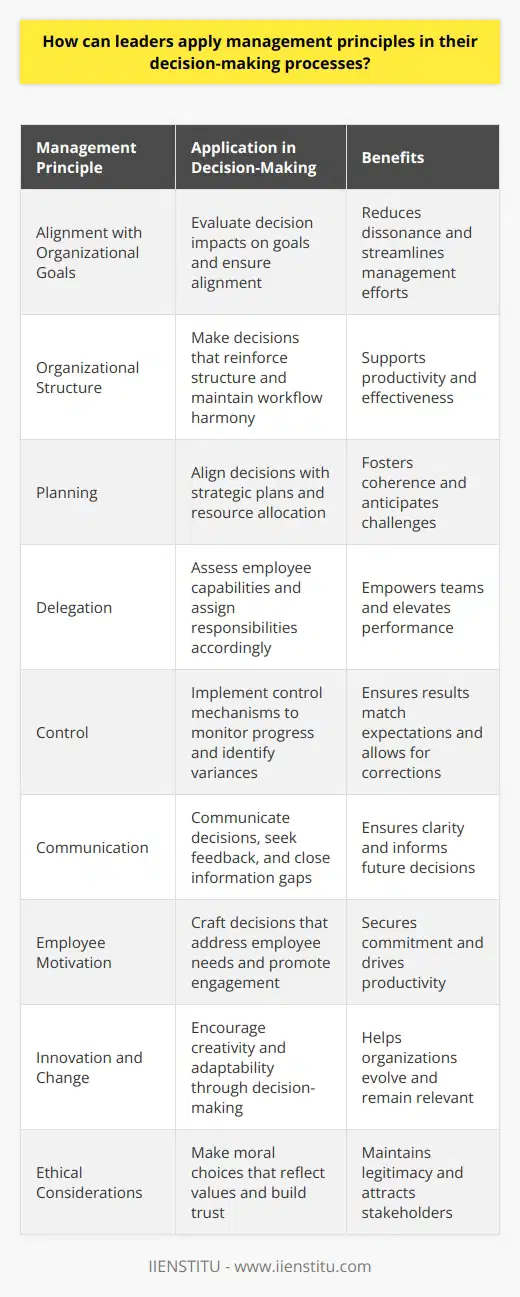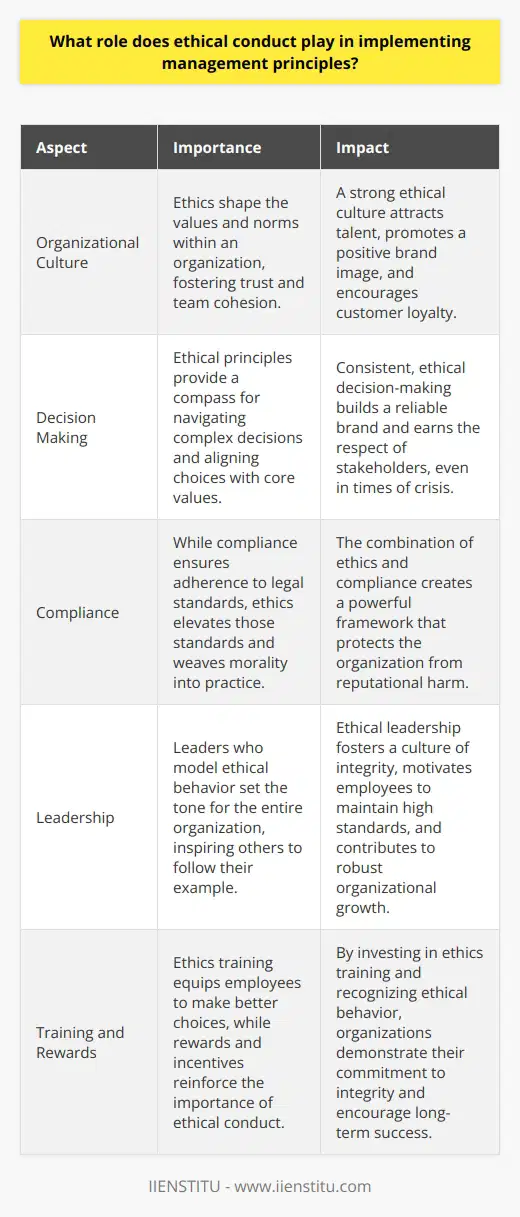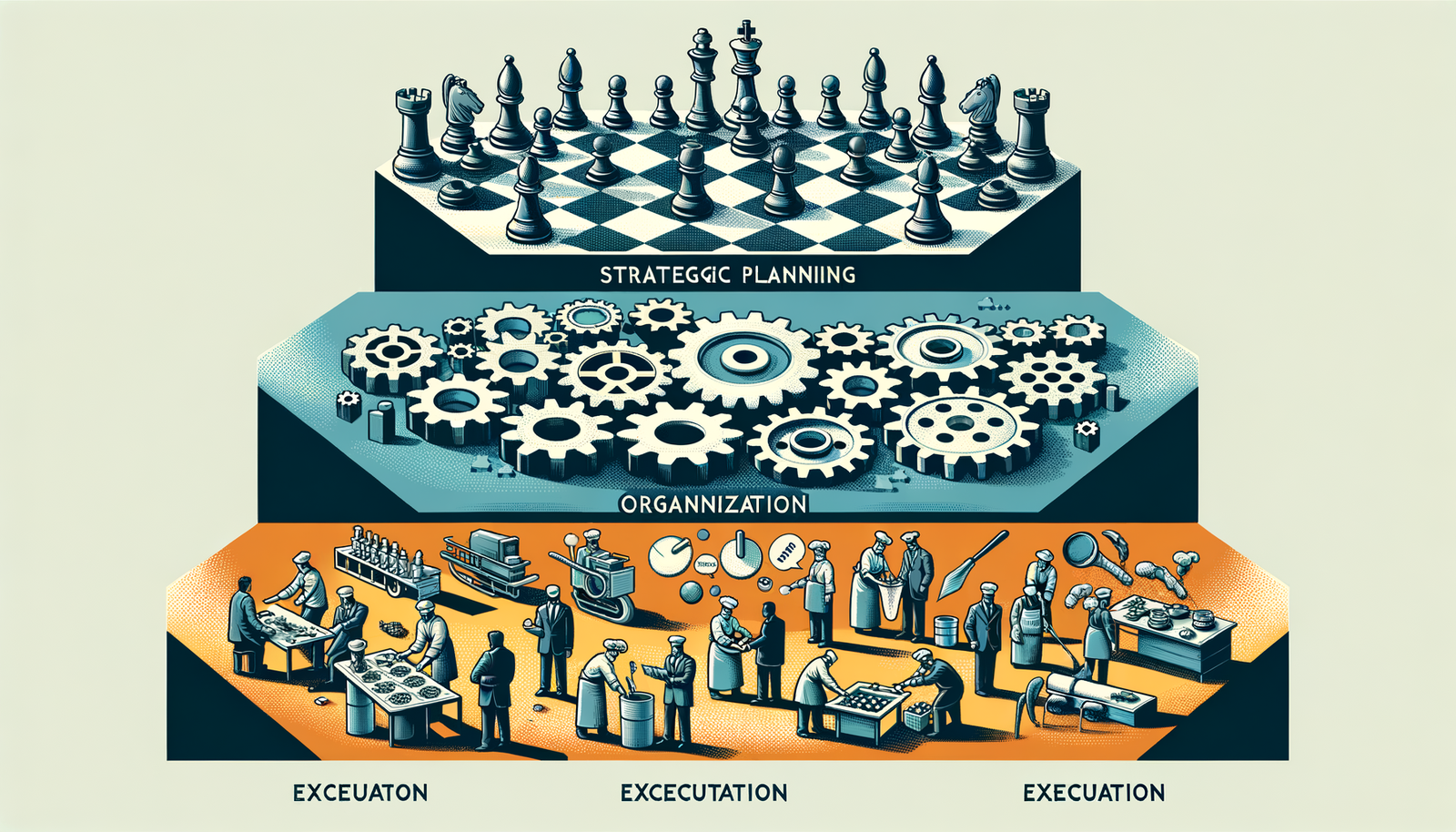
Management Principles: Essential Applications for Leaders
Management is the backbone of effective leadership; without robust management principles, leaders are like navigators without a compass. In this blog post, we will explore the synergy between foundational management practices and leadership excellence. This conversation not only serves as a guide to current and aspiring leaders but also affirms the criticality of management principles in steering organizations towards success. Here, the importance of these principles is not merely theoretical but is ingrained in the daily challenges of organizational life.
Understanding Essential Management Principles
Definition of Management Principles
Definition of Management Principles
Management principles act as the guideposts for organizational conduct and decision-making. The concept roots itself deeply in the history of administrative theory where scholars like Henri Fayol and Max Weber laid foundational ideas.
Free MBA course offerings often trace the evolution of these principles, highlighting their relevance from industrial revolutions to the digital age. With the rise of social and technological shifts, the role of management principles in modern leadership continuously adapts to new demands, embodying agility and foresight.
Core Management Principles
At the heart of management, there are several core principles that serve as the pillars of organizational function. These can be encapsulated into four major domains: planning, organizing, leading, and controlling. Planning sets the stage for future actions, defining goals, and charting out the necessary steps to reach them.
Organizing involves assembling and coordinating resources to implement the plan efficiently. Leading focuses on motivating and guiding team members towards achieving organizational objectives. Lastly, controlling requires evaluating performance against the set goals and implementing necessary adjustments.
How these Principles Interrelate with Effective Leadership
These principles are not isolated; they are part of a greater lattice that supports effective leadership. Insightful leaders understand that planning without proper organization is as ineffective as leading without control mechanisms.
Similarly, online courses with certificates in leadership often emphasize how these tenets are interdependent—leadership is as much about vision as it is about the systemic support that transforms that vision into reality.
Management principles act as the guideposts for organizational conduct and decision-making. The concept roots itself deeply in the history of administrative theory, where scholars like Henri Fayol and Max Weber laid foundational ideas. As noted in Wren's book "The Evolution of Management Thought" (2005), these early thinkers helped shape the understanding of management as a distinct discipline. Their contributions, such as Fayol's 14 principles of management, continue to resonate in modern leadership practices (Wren, 2005, p. 215).
Real-world Examples of Leadership Management
Incisive leadership is exemplified through its application in real-world scenarios. Whether it's a CEO leading a multinational corporation or a community leader guiding a local initiative, the principles of management ground their actions.
For instance, a CEO might use strategic planning to lead a company through a merger, ensuring all stakeholders are aligned with the vision and mission.
Steps for Effectively Applying Management Principles to Leadership
Applying management principles to leadership begins with a thorough situational analysis—understanding the environment, stakeholders, and challenges ahead.
Leaders must then adapt the principles to the context, customizing their approach to suit the specific needs and goals of their organizations. It's the hallmark of a reflective practitioner to engage in continuous improvement and learning, turning each experience into a learning opportunity.
Challenges and Solutions in Applying Management Principles
A pervasive challenge in leadership is the resistance to change. To overcome this, leaders can strategize by involving team members in decision-making processes and ensuring transparent communication.
Regular feedback and adapting to feedback are also critical, fostering an environment where management principles are not rigid rules, but tools for organizational growth and stability.
With the rise of social and technological shifts, the role of management principles in modern leadership continuously adapts to new demands, embodying agility and foresight. As Drucker highlighted in his seminal work "Management Challenges for the 21st Century" (1999), the changing nature of work and the knowledge economy necessitate a reevaluation of traditional management approaches (Drucker, 1999, p. 17).
Core Management Principles
At the heart of management, there are several core principles that serve as the pillars of organizational function. These can be encapsulated into four major domains: planning, organizing, leading, and controlling.
1- Planning sets the stage for future actions, defining goals, and charting out the necessary steps to reach them.
2- Organizing involves assembling and coordinating resources to implement the plan efficiently.
3- Leading focuses on motivating and guiding team members towards achieving organizational objectives.
4- Lastly, controlling requires evaluating performance against the set goals and implementing necessary adjustments.
Developing a Management Mindset in Leadership Roles
Leaders must align their thinking with management best practices. Cultivating a management-oriented thought process involves understanding the nuances of strategic planning, organizational structure, team motivation, and performance measurement.
Techniques for fostering this mindset include regularly engaging with case studies, seeking mentorship, and participating in simulations and role-playing exercises that mirror real management challenges.
Tips for Integrating Management Principles into Daily Leadership Practice
To make these principles a part of daily leadership practice, leaders should adopt specific routines and habits that orient their actions toward management efficacy.
This might include periodic reviews of organizational objectives, stakeholder engagement plans, or continuous learning through professional development opportunities. Emphasis should also be placed on developing soft skills, which are essential in applying these principles effectively.
Resources for Leaders to Enhance their Management Skills
Leaders looking to enhance their management skills have a wealth of resources at their disposal, from recommended readings on leadership theory to free MBA course work that provides comprehensive training on management principles. Leaders can also benefit from networks and organizations that provide support, mentorship, and platforms for sharing knowledge and experiences.
Koontz and O'Donnell, in their book "Principles of Management: An Analysis of Managerial Functions" (1972), underscore the universality of these principles across different types of organizations and levels of management (Koontz & O'Donnell, 1972, p. 53).
How these Principles Interrelate with Effective Leadership
These principles are not isolated; they are part of a greater lattice that supports effective leadership. Insightful leaders understand that planning without proper organization is as ineffective as leading without control mechanisms. Similarly, Northouse, in his book "Leadership: Theory and Practice" (2019), emphasizes how these tenets are interdependent--leadership is as much about vision as it is about the systemic support that transforms that vision into reality (Northouse, 2019, p. 94).
Application of Management Principles in Leadership Scenarios
Real-world Examples of Leadership Management
Incisive leadership is exemplified through its application in real-world scenarios. Whether it's a CEO leading a multinational corporation or a community leader guiding a local initiative, the principles of management ground their actions. For instance, a CEO might use strategic planning to lead a company through a merger, ensuring all stakeholders are aligned with the vision and mission.
In "Good to Great" (2001), Collins provides a compelling example of how Darwin Smith, CEO of Kimberly-Clark, used strategic planning to transform the company from a mediocre paper mill into a leading consumer products company (Collins, 2001, p. 17). This exemplifies how effective planning can steer an organization towards success.
Steps for Effectively Applying Management Principles to Leadership
Applying management principles to leadership begins with a thorough situational analysis--understanding the environment, stakeholders, and challenges ahead. Leaders must then adapt the principles to the context, customizing their approach to suit the specific needs and goals of their organizations. It's the hallmark of a reflective practitioner to engage in continuous improvement and learning, turning each experience into a learning opportunity.
Schön, in his book "The Reflective Practitioner" (1983), highlights how this process of reflection-in-action allows leaders to cope with the unique, uncertain, and conflicted situations of practice (Schön, 1983, p. 50). This reflective approach is crucial for effectively applying management principles in dynamic leadership contexts.
Challenges and Solutions in Applying Management Principles
A pervasive challenge in leadership is the resistance to change. To overcome this, leaders can strategize by involving team members in decision-making processes and ensuring transparent communication. Regular feedback and adapting to feedback are also critical, fostering an environment where management principles are not rigid rules, but tools for organizational growth and stability.
Kotter, in his book "Leading Change" (1996), offers an eight-step process for successfully navigating organizational change, which includes creating a sense of urgency, forming a powerful coalition, and anchoring new approaches in the culture (Kotter, 1996, p. 21). These strategies can help leaders overcome challenges in applying management principles during times of change.
Case Studies: Leadership Applications of Management Principles
Case Study 1: Transformational Leadership and the Implementation of Effective Planning
Consider a technology startup entering a competitive market. The leader, using transformational leadership, might start with creating an innovative vision, which is the bedrock of their strategic planning process. Bass and Riggio, in their book "Transformational Leadership" (2006), describe how transformational leaders stimulate followers to be creative and innovative, and to challenge their own beliefs and values as well as those of the leader and the organization (Bass & Riggio, 2006, p. 7).
In this case, the leader's vision could involve disrupting the market with a groundbreaking product. The planning process would then involve setting clear goals, allocating resources, and creating a roadmap for product development and launch. This case reveals how proper planning, integrated with the leader's transformational vision, can galvanize a team, allocate resources effectively, and position the company for competitive advantage.
Case Study 2: Organizational Change through Strategic Organizing
Organizing principles are best illustrated when a company faces an organizational challenge, such as restructuring. Leaders must deploy these principles to preserve the core of the organization while navigating the changes required to improve efficiency and productivity.
For example, when Louis Gerstner took over as CEO of IBM in 1993, the company was on the brink of collapse. Gerstner used strategic organizing to streamline the company, as detailed in his book "Who Says Elephants Can't Dance?" (2002). He dismantled the company's bureaucratic structure, empowered employees, and refocused the company on customer needs (Gerstner, 2002, p. 77). This case demonstrates how organizing can mitigate the adverse effects of organizational change and lead to a more structured and efficient operation.
Case Study 3: Results-based Leadership and Control Mechanisms
Finally, examine a scenario where a sales department is underperforming. Results-based leadership might involve setting clear sales targets and introducing control mechanisms such as performance dashboards and regular reviews.
Doerr, in his book "Measure What Matters" (2018), presents the case of Google's use of OKRs (Objectives and Key Results) as a control mechanism. The sales team used OKRs to set ambitious targets, track progress, and align their efforts with the company's overall mission (Doerr, 2018, p. 39). This case illustrates how controlling principles, when applied correctly, become tools for leaders to track progress actively, make informed decisions, and adjust strategies for better outcomes.
Management for Leaders: Best Practices and Guidelines
Developing a Management Mindset in Leadership Roles
Leaders must align their thinking with management best practices. Cultivating a management-oriented thought process involves understanding the nuances of strategic planning, organizational structure, team motivation, and performance measurement.
Mintzberg, in his book "Managers Not MBAs" (2004), argues that management education should focus on developing the skills, insights, and reflexes that enable practitioners to deal with the messy reality of organizational life (Mintzberg, 2004, p. 9). Techniques for fostering this mindset include regularly engaging with case studies, seeking mentorship, and participating in simulations and role-playing exercises that mirror real management challenges.
Tips for Integrating Management Principles into Daily Leadership Practice
To make these principles a part of daily leadership practice, leaders should adopt specific routines and habits that orient their actions toward management efficacy. This might include periodic reviews of organizational objectives, stakeholder engagement plans, or continuous learning through professional development opportunities.
Drucker, in "The Effective Executive" (1967), suggests practices such as time management, result-oriented thinking, and building on strengths (Drucker, 1967, p. 25). Emphasis should also be placed on developing soft skills, which are essential in applying these principles effectively.
Resources for Leaders to Enhance their Management Skills
Leaders looking to enhance their management skills have a wealth of resources at their disposal, from recommended readings on leadership theory to the practical applications outlined in Goleman's "Primal Leadership" (2013), which highlights the importance of emotional intelligence in leadership effectiveness (Goleman, 2013, p. 3).
Leaders can also benefit from networks and organizations that provide support, mentorship, and platforms for sharing knowledge and experiences. For instance, the American Management Association offers a variety of training programs and resources for managers and leaders at all levels.
In the discourse on management principles in leadership, one thing is clear: mastery of these principles is not an option but a necessity for leaders intent on achieving excellence and organizational success. Leaders are encouraged to proactively apply these principles, integrating them into their strategic vision and operational tactics.
We invite you to engage with these ideas, reflect on your leadership practices, and share your feedback. As the management landscape evolves, so too should our approaches, always striving for better, more effective leadership.
References
Bass, B. M., & Riggio, R. E. (2006). Transformational leadership (2nd ed.). Lawrence Erlbaum Associates.
Collins, J. (2001). Good to great: Why some companies make the leap...and others don't. HarperBusiness.
Doerr, J. (2018). Measure what matters: How Google, Bono, and the Gates Foundation rock the world with OKRs. Portfolio.
Drucker, P. F. (1967). The effective executive. Harper & Row.
Drucker, P. F. (1999). Management challenges for the 21st century. HarperBusiness.
Gerstner, L. V. (2002). Who says elephants can't dance? Inside IBM's historic turnaround. HarperCollins.
Goleman, D. (2013). Primal leadership: Unleashing the power of emotional intelligence. Harvard Business Review Press.
Koontz, H., & O'Donnell, C. (1972). Principles of management: An analysis of managerial functions (5th ed.). McGraw-Hill.
Kotter, J. P. (1996). Leading change. Harvard Business School Press.
Mintzberg, H. (2004). Managers not MBAs: A hard look at the soft practice of managing and management development. Berrett-Koehler Publishers.
Northouse, P. G. (2019). Leadership: Theory and practice (8th ed.). SAGE Publications.
Schön, D. A. (1983). The reflective practitioner: How professionals think in action. Basic Books.
Wren, D. A. (2005). The history of management thought (5th ed.). Wiley.
Frequently Asked Questions
What are the core principles of effective management in a diverse workforce?
Understanding Diversity in the Workplace
Diversity encompasses various dimensions. These include culture, race, gender, age, and more. Effective management in such environments is crucial. It requires understanding and skill.
Core Principles of Effective Management
Embrace and Value Differences
Managers must recognize each individual's unique traits. They should value these differences. This builds a culture of respect. Mutual respect fosters a positive work environment.
Practice Inclusive Leadership
Inclusive leadership is key. It ensures that all team members feel involved. Their opinions and contributions gain equal weight. This promotes a sense of belonging.
Communicate Effectively
Clear communication is essential. It breaks down barriers. It also conveys respect and understanding. Managers must adapt their communication styles. Such adaptation meets the needs of a diverse team.
Provide Equal Opportunities
Equal opportunity drives fairness. It enables all employees to thrive. Discrimination has no place in effective management. Bias in any form undermines team cohesion.
Educate Your Team
Education combats ignorance. It promotes understanding and tolerance. Teams should learn about diversity and its benefits. Continuous learning supports an inclusive workplace culture.
Foster a Safe Environment
A safe working environment is vital. Employees must feel free to express themselves. They need protection against harassment and discrimination. Security in the workplace boosts confidence and productivity.
Adapt and Innovate
Diverse teams bring various perspectives. Managers can harness this to innovate. Adaptability is crucial in our ever-changing world. It allows for diverse solutions to emerge.
Advocate for Fair Treatment
Managers must ensure fair treatment. They should advocate for fairness and equality. Favoritism damages teams. Fairness strengthens them.
Establish Clear Anti-Discrimination Policies
Clear policies against discrimination are crucial. They set the tone for the organization. They signal a commitment to diversity. They also provide guidance on appropriate behavior.
Regularly Review and Improve Practices
Continuous improvement is necessary. Regular reviews of policies and practices help. They ensure that management remains effective. They also make sure that diversity efforts are on track.
Implementing these core principles leads to effective management. Diverse workforces benefit from such leadership. They become more inclusive, innovative, and productive when managed well.

How can leaders apply management principles in their decision-making processes?
Understanding Management Principles
Management principles guide leaders. They shape decision-making. Leaders apply these principles consciously. The principles offer frameworks. They offer insights. Principles help predict outcomes. They ensure consistency. They align decisions with goals.
Decision-Making and Organizational Goals
Goals guide leaders. Each decision affects these goals. Leaders start here. They evaluate decision impacts. Alignment is key. Decisions should propel goals. It reduces dissonance. It streamlines management efforts.
The Principle of Organizational Structure
Structure influences effectiveness. Leaders recognize this. Decisions should reinforce structure. They should not disrupt workflows. Leaders must ensure harmony. This supports productivity.
Planning as a Guideline
Planning precedes action. It involves forecasting. It requires strategizing. Leaders use planning. They anticipate challenges. They allocate resources. Decisions must align with plans. This fosters coherence.
The Role of Delegation
Delegation empowers teams. Leaders must delegate wisely. They trust employees. They share responsibilities. Decisions reflect this trust. Leaders assess capabilities. They assign accordingly. Effective delegation elevates performance.
The Importance of Control
Control verifies performance. Leaders set standards. They monitor progress. Control mechanisms matter. Decision-making requires these checks. Leaders identify variances. They implement corrections. Control ensures results match expectations.
Communication as a Foundation
Communication is essential. It underpins management. Leaders communicate decisions. They seek feedback. Feedback informs decisions. This cycle is critical. It closes information gaps. It ensures clarity.
Emphasizing Employee Motivation
Motivation drives productivity. Leaders understand this. They craft motivating decisions. They consider employee needs. They address these needs. This approach promotes engagement. It secures commitment.
Encouraging Innovation and Change
Change is constant. Leaders embrace it. They champion innovation. Decisions should reflect adaptability. They should encourage creativity. This helps organizations evolve. It keeps them relevant.
Ethical Considerations in Decision-Making
Ethics provide a compass. Leaders adhere to ethics. They make moral choices. Decisions reflect values. Ethical considerations build trust. They maintain legitimacy. They attract stakeholders.
Applying Management Principles Effectively
In conclusion, leaders integrate management principles. They apply them thoughtfully. They consider impacts. They assess fit. They aim for consistency. Decision-making becomes more reliable. Organizations thrive. Management principles underpin success. Leaders follow them diligently. They craft a resilient future. They ensure sustainable growth. This approach is indispensable. It defines effective leadership.

What role does ethical conduct play in implementing management principles?
Ethical Conduct in Management Principles
Management principles guide organizations. They set foundations for decision-making processes. Ethical conduct, however, turns these abstract ideas into practical strategies. It breathes life into management principles.
The Significance of Ethics
Ethics shape organizational culture. Integrity and fairness become cornerstones. They foster trust. Employees look up to leaders who act ethically. Their example motivates others. Indeed, ethical behavior strengthens team cohesion.
Leaders with strong ethics inspire confidence. They draw the best from their teams. Their reputation for honesty attracts talent. It promotes a positive brand image. Customers gravitate towards ethical companies. Such firms enjoy sustained patronage.
Ethics in Decision Making
Ethical conduct affects every decision. It guides choices towards greater good. Managers face dilemmas. Ethical principles provide a compass. They help navigate through grey areas. Choices align with core values. This consistency builds a reliable brand.
In crisis, ethics prove pivotal. They demand tough, but fair calls. Stakeholders respect leaders who remain principled. These decisions often define a leader's legacy.
Ethics and Compliance
Complying with the law is baseline. Ethics goes beyond that. Laws set minimal standards. Ethics elevate those standards. Ethical leaders pursue excellence. They ensure that actions reflect values.
Compliance checks legal boxes. Ethics weave morality into practice. Together, they create a powerful framework. They protect the organization from reputational harm.
Incorporating Ethics into Management Principles
Leaders model ethical behavior. They talk the talk and walk the walk. Team members imitate this conduct. The right behavior becomes the norm.
Ethics training is crucial. It fills gaps in understanding. It equips employees to make better choices. Strong ethical policies support this training. They outline expected behaviors.
Feedback mechanisms encourage ethical conduct. They allow for praise and correction. Organizations stay on the right track. They grow an ethical culture.
Rewards recognize ethical behavior. They motivate employees to keep standards high. Incentives prove that ethics matter. They show that the organization values integrity.
In conclusion, ethical conduct is indispensable. It reinforces management principles. It streamlines decision-making. It enhances compliance. It molds corporate culture. Solid ethical foundations lead to robust organizational growth. Strong ethics engender lasting success.



